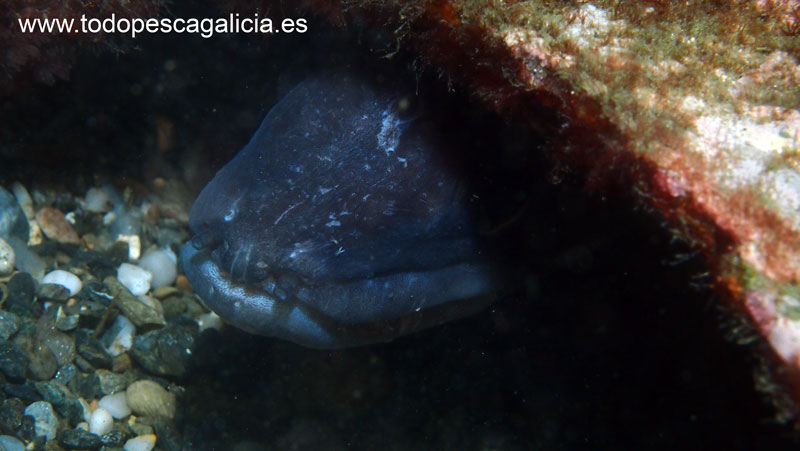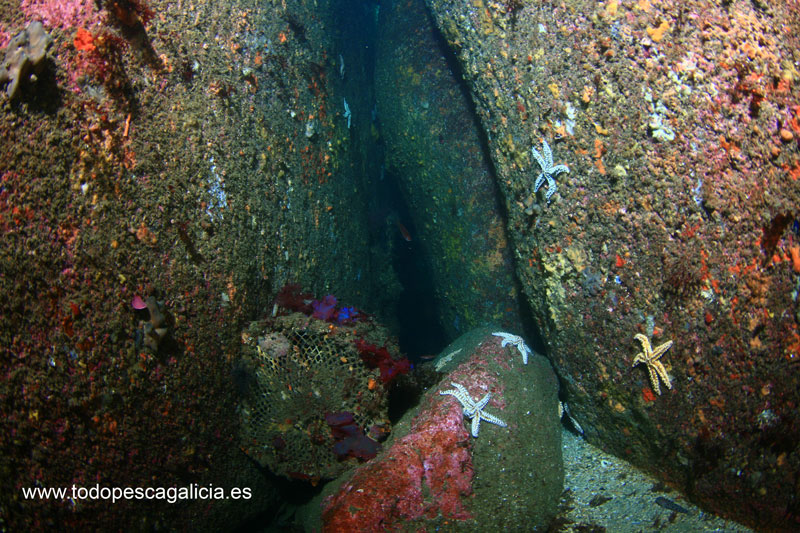THE CONGER (CONGER CONGER)
This fish, with long shape, like a large eel, has awaken admiration and respect among the fishermen. Admiration due to the huge size it can grow to. And respect due to the aggressiveness it can show sometimes. With a big mouth, it can become dangerous during the capture, although as we will see along this text, it won’t have any problem if we act with a little bit of precaution and knowledge.
It can reach big weights, over 50 Kg, and being normal 15 or 20 Kg. Although the most common are the catches between 6 and 15 Kg.

It is easy to fish, and we only have to find it in its cave. The capture after finding it will be limited to the shot. But the thing can get difficult here. Depending on the cave we find it, sometimes it won’t be possible to aim properly (due to being to closed and not let us move the speargun inside). Or if it’s too deep, the animal can go to the bottom after the shot and get stuck or stay far enough that we can’t reach the shaft to pull it. We will see in depth the best ways of acting.
LOCALIZATION
The conger is an animal that, except on limited occasions on which we will be able to see it swimming (especially in the kelp), we will always look for it in caves. Besides, the good conger caves will have one almost always. When one is captured, another one will take up the place soon (and it will have a similar size). 
So then, we have to look for the good caves. They are oriented to the shore or to a sheltered area normally, and not facing the open sea (which would be more uncomfortable due to the permanent pounding of the sea). The caves that are quite closed, offering shelter, are often the best ones.
We shouldn’t think that they need big holes. A lot of the time, one single crack, very narrow, will be enough.
It likes estuary bottoms, sand and even muddy ones. And the depth is very changing, from a couple of meters (never in the intertidal zone) to further more than the reachable depths for spearfishermen (more than 100m).
One usual feature is the presence of shell fish. In the conger caves will be uncommon to not find some velvet crabs, prawn, spider crab or small European locust lobsters. Even European lobsters. These feed themselves with left overs and above all they get protection against their worst enemy, the octopus. Which is the favorite catch of the conger. 
SEASON
It will be irrelevant, it will be always present. And it can be a great resource for days with few fish activity, to go over or look for their caves.
GEAR
Of course, the torch is a must. We will need it to be able to check the caves in depth. A short gun, 75 cm or even a 60cm with powerful rubber bands. A hook, like the ones used to extract the groupers can be recommendable (and also for the octopus). 7 mm shaft to reduce the chances of getting bended.
CAPTURE
The most important thing during the capture of a conger is the shot. If we do it right and we kill it, no problem will arise. But although the shot is going to be very easy, usually point-black and with a lot of time to aim, is not easy to kill it on the first shot.
We can find them in four positions mainly:
Showing the tail: if it’s showing the tail, and we don’t have the option of aiming the head because we can’t see it, leaving it is the most advisable option. Don’t shot. If we do it, the task of extracting it would be hard. Bended shafts, tears and leaving the animal hurt… And if we could extract it, there would be a risk of getting bitten or tangled. When we find it in this situation, we can try to prick it a little bit on the tail, to annoy it a bit. It’s possible that when we dive again it had changed its position. 
Facing it, with a straight shot: when it’s facing towards us. We can aim for a shot a little bit from up to down, looking for the brain and kill it with one shot. Another option is to skewer it, making the shaft go totally inside, from the head to the tail, impeding it to turn. The shoot in this situation has to be done above the eyes, like drawing a triangle.
From the side, perpendicular:. The shot will be made at the eyes level and a couple of centimeters behind. If we are able to, it’s better to try to do it a bit diagonal, not totally perpendicular to the conger, to have more chances to kill the animal instantly.
Diagonal, a bit in front of us: It’s probably the best situation. A shot right behind the eye, diagonal to the back. We can also shoot right on the eye or even a bit ahead of it, trying to make the shaft go out a bit behind the other eye.
As we can see, we always have to try to kill the animal instantly, reaching the brain or the beginning of the spine on the join with the head. 
It’s very important that the shaft enters through the head and in a firm area. To avoid it being riped and be able to control its head in every moment. If we can squeeze it between the hand and the barb, we will have total control of the head and it won’t be able to hurt us or get its mouth close to us.
Something to take in mind is that the conger tends to twist , spinning around itself. If when it is doing it, it get tangled with the nylon, it can break it. Or even worse, if our hand is between the shaft and the nylon, we can get injured (cuts or broken bones). We should never let it press our hand between the shaft and the nylon.
With a good shot, all these risky situations get minimized. We shouldn’t be afraid of putting our hand close to its head around the shaft and hold firmly (of course, always far from the mouth). Once it’s secured, we can finish it off.
EXTRACTING IT OUT OF THE CAVE
If the shot was not perfect and it is a big conger, the task of extracting it out of the cave can be difficult. We can use the “beast technique” and pull like maniacs. Or we can do it by other ways. In competitions, when the task gets difficult and we can see it, it’s normal to go for a second shot. Even with a gun set up specially with a shaft without barb, to try to kill it. And if the shoot is missed, the shaft is recovered (because it doesn’t have a barb) and we try again.
Another technique is like with the grouper, use a buoy to get the work done for us. We will connect the gun to the buoy (or if it has a reel we will take it to the surface) and we tie it to the buoy, sinking it a bit, to exert a constant traction that will end up making the animal tiredand making it go outside of the cave. 
FINISHING IT OFF
It’s easy, with the knife in the rear part of the head. A bit behind the eyes. It’s a hard spot and we need a good knife. When we hold it between our hand and the barb, it’s a good way to check where is this spot to kill it and know where to aim the shot in future catches.
Something that can be done, to reduce the risk of getting bitten, is to cut the side tendons of the mouth. Although if we know how to do it, it won’t be necessary and we will avoid the animal to suffer.
HOW TO COOK IT
There are several dishes with conger, it is a high quality fish. Pies, cocktails, simply boiled… But it has a feature that scares a lot of people: the bones. A lot of them.
Due to this, it’s highly recommended not to capture the small ones. The best size, 8 kilos and more. And preferably use the area until the belly. The tail will be better for cake or other similar recipes, because is the part with the thinner bones.
Some extra tips about this catch are to clean very well after fishing it. The ‘slime’ that is around it gets stuck to all the gear, and when it dries, it’s difficult to clean. And above everything it smells really bad. We have to be careful that it doesn’t rub against boxes, bags, the suit… and if it does, clean it when it’s still wet.






































